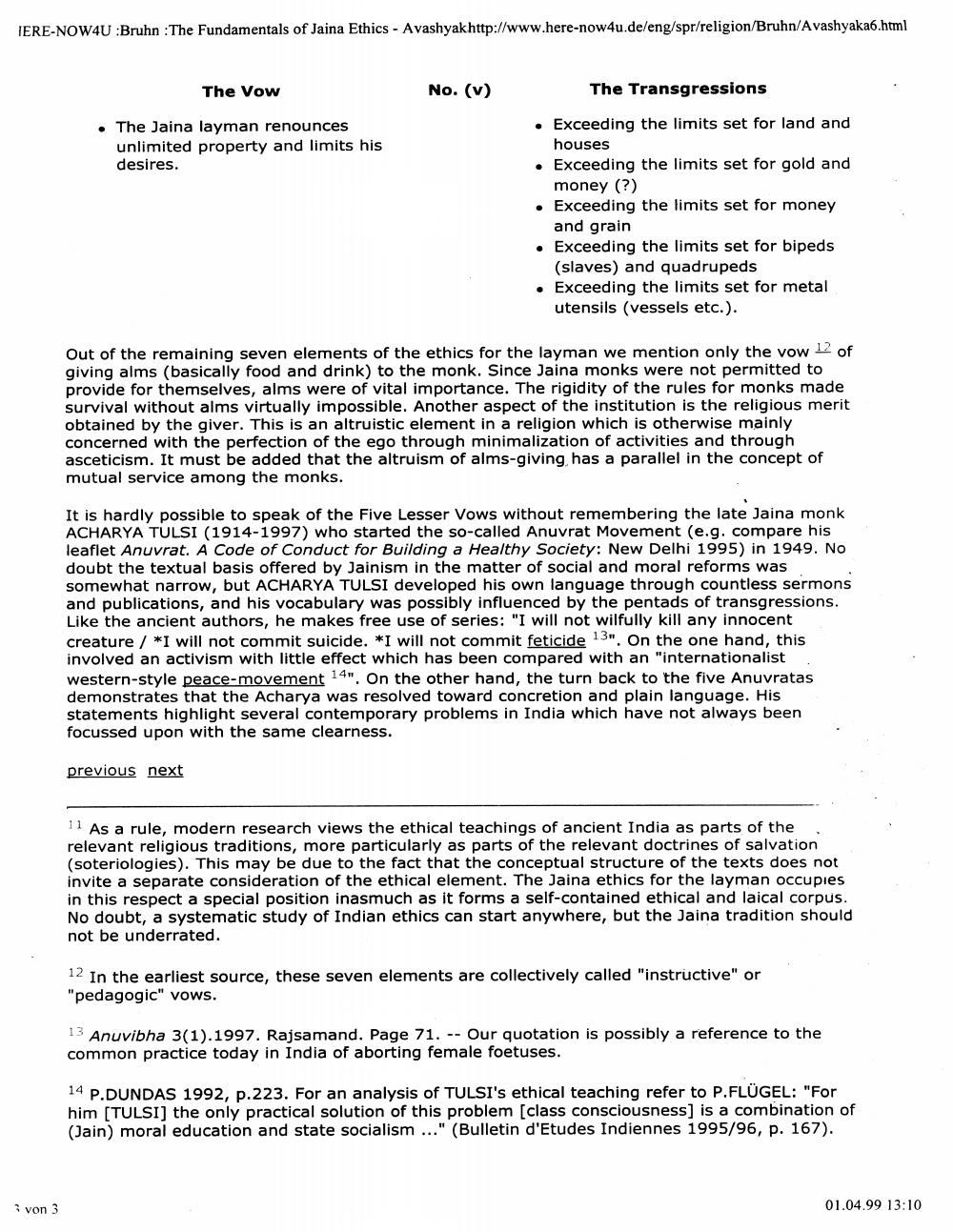________________
IERE-NOW4U :Bruhn : The Fundamentals of Jaina Ethics - Avashyak http://www.here-now4u.de/eng/spr/religion/Bruhn/Avashyaka6.html
The Vow
No. (v)
The Transgressions
• The Jaina layman renounces
unlimited property and limits his desires.
• Exceeding the limits set for land and
houses • Exceeding the limits set for gold and
money (?) • Exceeding the limits set for money
and grain • Exceeding the limits set for bipeds
(slaves) and quadrupeds • Exceeding the limits set for metal
utensils (vessels etc.).
Out of the remaining seven elements of the ethics for the layman we mention only the vow 12 of giving alms (basically food and drink) to the monk. Since Jaina monks were not permitted to provide for themselves, alms were of vital importance. The rigidity of the rules for monks made survival without alms virtually impossible. Another aspect of the institution is the religious merit obtained by the giver. This is an altruistic element in a religion which is otherwise mainly concerned with the perfection of the ego through minimalization of activities and through asceticism. It must be added that the altruism of alms-giving has a parallel in the concept of mutual service among the monks.
It is hardly possible to speak of the Five Lesser Vows without remembering the late Jaina monk ACHARYA TULSI (1914-1997) who started the so-called Anuvrat Movement (e.g. compare his leaflet Anuvrat. A Code of Conduct for Building a Healthy Society: New Delhi 1995) in 1949. No doubt the textual basis offered by Jainism in the matter of social and moral reforms was somewhat narrow, but ACHARYA TULSI developed his own language through countless sermons and publications, and his vocabulary was possibly influenced by the pentads of transgressions. Like the ancient authors, he makes free use of series: "I will not wilfully kill any innocent creature / *I will not commit suicide. *I will not commit feticide 13". On the one hand, this involved an activism with little effect which has been compared with an "internationalist western-style peace-movement 14". On the other hand, the turn back to the five Anuvratas demonstrates that the Acharya was resolved toward concretion and plain language. His statements highlight several contemporary problems in India which have not always been focussed upon with the same clearness.
previous next
11 As a rule, modern research views the ethical teachings of ancient India as parts of the relevant religious traditions, more particularly as parts of the relevant doctrines of salvation (soteriologies). This may be due to the fact that the conceptual structure of the texts does not invite a separate consideration of the ethical element. The Jaina ethics for the layman occupies in this respect a special position inasmuch as it forms a self-contained ethical and laical corpus. No doubt, a systematic study of Indian ethics can start anywhere, but the Jaina tradition should not be underrated.
12 In the earliest source, these seven elements are collectively called "instructive" or "pedagogic" vows.
13 Anuvibha 3(1).1997. Rajsamand. Page 71. -- Our quotation is possibly a reference to the common practice today in India of aborting female foetuses.
14 P.DUNDAS 1992, p. 223. For an analysis of TULSI's ethical teaching refer to P.FLÜGEL: "For him (TULSI] the only practical solution of this problem (class consciousness) is a combination of (Jain) moral education and state socialism ..." (Bulletin d'Etudes Indiennes 1995/96, p. 167).
von 3
01.04.99 13:10




